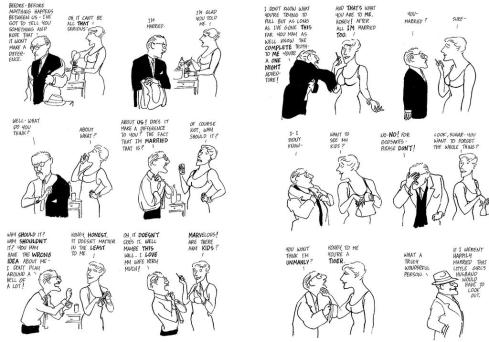
Today we learnt about another experiment, about conditioning, with dogs. Let me read you this bit:
“In a famous experiment by Shenger-Krestovnika, published in 1921, a dog was trained to salivate to a circle but not to an ellipse. The ellipse was then made progressively more like a circle. When the ratio of the axes of the ellipse was reduced to 9:8, the dog could discriminate it from a circle only with great difficulty. It showed some signs of success on this problem for about three weeks, but then its behavior was disrupted. It was unable to respond correctly not only on this difficult task, but also when presented with obvious ellipses and circles that had given it no trouble in the earlier part of the experiment. What is more, instead of coming to stand quietly in the apparatus of the past, the animal now showed extreme excitement, struggling and howling” (Gray, 1979).
I started feeling really peculiar when the lecturer was talking about that experiment because I realised that it could easily be a person he was talking about, and that circles could be good people, and ellipses could be bad people. Ellipses are squashed circles. Circles have the potential to become ellipses and ellipses have the possibility of being restored to circles, but sometimes somebody that looks like a circle gradually starts to collapse, to become more like an ellipse until, one day, you really cannot tell whether they are actually a circle or an ellipse. And then you feel mad inside because you don’t know how to behave towards them. Because you can trust a good person, a circle. You know they’ll show you respect, that they’ll be truthful to you, that they will do their utmost to be reliable, that they will show integrity with everything they do, that they’ll be kind, loving, patient, all those Biblical virtues. And that if they are tired or fed up or stressed at some point and don’t have the energy to be those things, they will want to make up for it afterwards, to apologise.
What about ellipses?
They are all the things that circles are not: unreliable, untrustworthy. They lie, dissemble, hide behind things. They hurt you rather than deal with something difficult. They ignore you. They malign you. They do not care how you feel because it is all about them. They are the hollow people whose self is elsewhere and who do not really exist in an encounter.
Gosh. Sounds awful. So how can you tell the difference?
Well, most of the time it’s easy. But just every now and again you meet someone who you think is a circle. They may be able to very convincingly present themselves as a circle, and sustain that for quite a long time, but then, slowly, so slowly that you almost don’t notice, a nagging feeling flits in and out. Perhaps this person is not a circle after all, but an ellipse in disguise. I think it’s rare for it to be the other way round – an apparent ellipse actually being a perfect circle. The devil can wear a saint’s clothes but it doesn’t happen the other way round. A nightmare, especially for a child. I’d like to read you this other bit. It’s chilling. It also goes on a bit, so bear with me …
“There is more to this story. Like Pavlov’s dogs, Gregory Bateson (1956) observed that a schizophrenic adult became that way because as a child, he could not discriminate whether his mother loves him or not! His theory of schizophrenia meshes in well with the ideas of Alice Miller. When kids ask their parents “Why am I being spanked,” the parent invariably responds “For Your Own Good,” which is the title of one of her books. It is a contradiction of terms and concepts! You don’t say to a child “I love you,” and then give the child a whack! It is entirely inconsistent! Any young kid can tell you that! Read an anecdote by Astrid Lindgren (1978) [follow the link] to get a feeling from the child’s point of view. What Bateson observed was that the child who grows up to be a schizophrenic is forever receiving two conflicting messages that put him into a double bind. The mother says to her child “I love you,” but when the child comes to hug, the mother pushes the child away, or stiffens in response to the hug. She really doesn’t love the child, but society says she should. So she pretends to love her child. But then the child senses the other message, and pulls away, and the mother then condemns the child with, “How come you don’t love me?” This cycle of responses is related to the biblical law “Thou shalt honor thy father and mother,” and if you don’t, well then you have to pretend, and the internal conflict makes you go crazy. It’s damned if you do, damned if you don’t.”
Shit. Horrible. Beware False Circles.
Exactly. Only thing is, you don’t know that you’ve met one until it’s too late. They’re good, False Circles. Had a lifetime of practice. You won’t get them to change. They’re ellipses for life because they’d rather be ellipses than go through the pain of transformation from ellipse to circle, even though they were born beautiful, perfect circles. Sooner or later you’ll get the crazies when you’re with them, though, and then you know you’ve met one. It’s not as if they have it branded on their forehead – quite the contrary. But trust your gut rather than them. Thing is, most of us don’t want to believe that someone we’ve seen as a circle is anything other than a circle, so ellipses get away with it for a long time, while we slowly get more and more crazy. I think that’s partly about our ego, about not wanting to admit that we’ve made a mistake. But I also honestly think it is about really not wanting to label someone as an ellipse. It is such a hard thing to do, even if your sanity and happiness and health depend on it, because it feels as if it giving up on someone. I never want to do that. And that unwillingness works in favour of ellipses and enables them to carry on longer than is good for you.
Don’t they ever change?
No. I don’t think they do. No. Sadly I don’t think they do. They could, but they don’t.
Poor Elipses.
Well, perhaps. Hopefully they may be other people’s circles. That’s what I hope, anyway. For their sake. I hope it’s just the position from which I’m looking at things that makes me see them as elipses, and that if I was a different person, with a different perspective, I’d see them as a circle.
Always the optimist!
Nearly always …
















Recent Comments